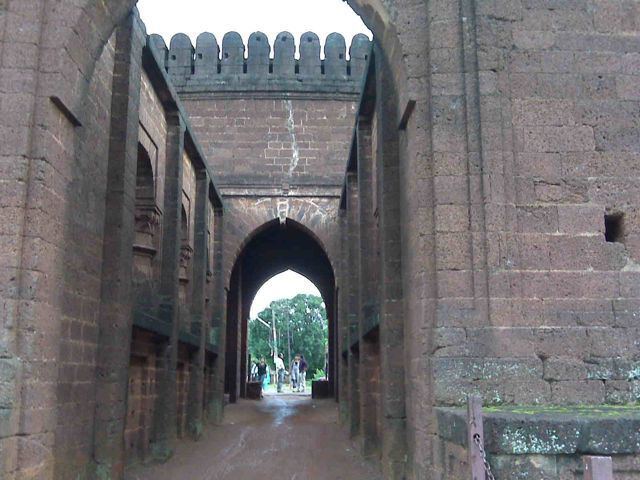 | ||
The Bishnupur gharana (alternatively spelt Vishnupur gharana) (pronounced as /biʃ.nu.pur gʱɔ.ra.na/) is a form of singing that follows the Dhrupad tradition of Hindustani music, one of the two forms of Indian classical music. It originated in Bishnupur, West Bengal, India in late 18th-century. The name of the town means "city of Vishnu" in Bengali. In the ancient past, this area, known as Mallabhum was the abode of Malla Kings who were vassals to the Mughal Empire who were devotees of Lord Vishnu and patrons of music. Bishnupur Gharana was established in 1370 A. D. by the court musicians of Malla Kings. Historians suggest that 'Mallabhum' had once been the cultural centre of Eastern India. It also has the distinction of being the only Gharana in West Bengal.
Contents
History
The gharana is reputed to have been established in the 13th century, even though there is no historic evidence to support this. In the 17th century, during the reign of Mughal emperor Aurangazeb, Islamic fanaticism was at its peak in the Mughal empire, and thus many musicians moved to the court of the Maharaja of Bishnupur who was a known patron of the arts. The famous Dhrupad Singer Bahadur Khan of the Senia Gharana, descendant of Tansen, fled to Bishnupur and made his Gharana popular and sought refuge in the court. Bahadur Khan was not only a vocalist but could also efficiently play on such instruments as the Veena, the Rabaab, the surashringaar. The king, Raghunath Singh Deo II, made all arrangements to honour him as his court singer. The Maharaja also announced that anyone having a sweet voice and interested in music could learn from Bahadur Khan without any fees. He also bore the financial liability for the poor students. In time, a good number of students became the disciples of Bahadur Khan.
Historical evidence points to Pt. Ramachandra Bhattacharya, a disciple of Ud. Bahadur Khan as the founder of the gharana. Bishnupur Gharana therefore has a strong link to Betia Gharana through this unbroken relationship.
In the later part of the eighteenth century and towards the early and mid-nineteenth century, when music of different 'Gharanas' were gradually assimilating around the Khayal style, the Dhrupad style continued flourishing among the musicians of Bishnupur.
Vishnu Narayan Bhatkhande desired to be a disciple of Radhika Prasad Goswami since he found the most authentic renditions of the ragas and the most exhaustive repertoire of songs in Bishnupur Gharana (Reference:-Brammhoman by Dilip Kumar & Jugantor)
In 1921 when Prince Edward came to visit India, six artists of various gharanas were chosen to perform six Ragas for six Seasons. Three of them were from Bishnupur Gharana: Gopeswar Bandyopadhyay, Satyakinkar Bandyopadhyay and Khetra Mohan Goswami.
First maiden Gramophone record in Khayal in 1902 " Tara Parameshwari " by Lal Chand Baral,who learnt under Ramprassanna Bandyopadhyay (Vide Sangeet Chandrika) published by Gramophone Concert and Nicole.
First Dhrupad record in 1902 "Naad Bidya Sabse Sera" Raag Darbari, Taal Choutal, by Surendranath Bandyopadhyay published by Gramophone Concert. Khayal started from Ramshankar Bhattachariya's age. His writings on Khayal is being found "Bramhamoyi Paratpara", on the Raga "Yaman Kalyan".
Ramprasanna Bandyopadhyay was the foremost Surbahar and Sitar Artist of India up to 1928 (Vide: Sarojini Naidu's memoirs, Pramoth nath chowdhuries writings).
Vishnu Narayan Bhatkhande first came across the Ustads of Bishnupur in a conference in Benaras around 1921/22 and this conference was attended by Radhika Prasad Goswami, Gopeswar Bandyopadhyay and Satyakinkar Bandyopadhyay. They gave a trio performance in Dhrupad (Since at that time Dhrupad Artists used to perform duets so in answer to that, they gave a trio performance). After this they gave individual performance.
Style of singing
In this style, the artist excels in unfolding the beauty of the Raga through the alap. It is simple, devoid of heavy, cumbersome ornamentation. It is free from intricate play with the rhythm. Layakari is however allowed in Dhamar, another form of vocalisation. The Khayal of the Bishnupur School is noted for its sweet, lilting melody. It is adorned with the usual ornaments, which add variety to the melodic presentation of the Raga.
The dhrupad of the Bishnupur gharana uses shuddha dhaivata in raga vasanta, a touch of komal nisada in the descending notes of Raga Bhairava. It has abandoned kadi madhyam (proper center) in raga ramakeli, and uses suddha dhaivata in raga puravi and Raga Lalita and komal nisad in raga vehaga. It has also developed its own character with regard to rhythm. It was this gharana which invented the tradition of Sawal-Jabab in Hindustani Music.n
Its origins and the development have led to a great openness in the teaching and evolution within this gharana.
Famous musicians
Most of the exponents of Bishnupur learnt Dhrupad vocal and instrumental music simultaneously.
In spite of producing such a talented group of musicians, Bishnupur lacked venues for performances. This prevented Bishnupur from becoming a performance center for the artists of the gharana.It was only in 2007 that an auditorium was opened in the town enabling public performances in the music of the gharana to the listening public.
